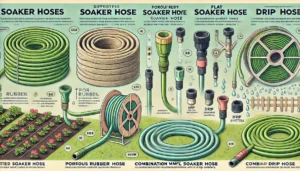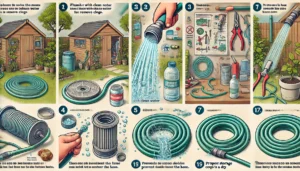The Ultimate Guide to Soaker Hoses: Everything You Need to Know
The soaker hose can be used to create a lush, healthy and beautiful garden. Understanding the uses and benefits of soaker hoses, whether you’re a new or an expert, will help you achieve greater success in your garden creation journey. The comprehensive guide will teach you everything about the benefits and uses of soaker hoses. It also explains how to maintain and use them.
What is a Soaker hose?

A soaker hose releases water slowly along its length to water soil directly. Soaker hoses, unlike sprinklers or pipes that spray water in the air or at a large area, are designed to be laid out on the ground and hidden beneath mulch. This allows water to slowly permeate the soil. This method of watering is extremely efficient and aids in making certain that the water goes straight to the origins, where it’s required most.
Soaker tubes are commonly utilized for watering blossom beds, vegetable gardens, grass, and trees. They are especially effective and work best for drip irrigation systems and locations with irregular terrain where typical watering techniques might not function well compared to it.
This article contains affiliate links to Amazon, which means I may earn a commission if you purchase through these links.
How To Do Soaker Hoses Work?

Soaker pipes are commonly made from rubber, porous material, or a combination of both. The water is pumped through the hose at reduced stress and runs away with small pores or weeps along the size of the hose. This process permits the water to seep straight into the soil, making certain that plants get a stable supply of wetness without runoff or evaporation losses.
Soaker hose pipes are generally linked to a tap or garden hose and can be laid out in any arrangement– whether that’s in a straight line, a circle, or a zigzag pattern– depending on the area that needs to be sprinkled.
Many soaker pipes also include adapters that allow you to link numerous tubes with each other, which is excellent for larger areas or for covering garden beds that prolong beyond the size of a solitary hose.
Secret Benefits of Soaker Hoses

There are several reasons why gardeners like soaker hoses over conventional automatic sprinklers or hand watering. Below are a few of the vital advantages:
1. Water Efficiency
One of the main benefits of a soaker hose is its water effectiveness. Conventional lawn sprinklers tend to drain through evaporation or drainage, especially in gusty or hot conditions. Soaker tubes, on the other hand, provide water directly to the dirt, minimizing waste. Since they sprinkle the ground as opposed to splashing water into the air, soaker hoses are optimal for preserving water and decreasing your general water costs.
2. Deep Root Watering
Soaker hose pipes give a slow-moving, consistent supply of water that can pass through deep right into the dirt. This encourages deep root growth, which helps plants establish more powerful and much healthier root systems. Deep watering is especially vital for drought-resistant plants and trees, as it ensures that the origins can access wetness also when the surface soil dries.
3. Protects Against Watering
Diseases Watering from above– especially making use of lawn sprinklers– can bring about fungal illness and mold development on plants, specifically when water arrives on the leaves. By utilizing a soaker hose, you can guarantee that the water gets to the soil and not the vegetation. This can help reduce the threat of leaf diseases that prosper in moist environments.
4. Conserves Time and Effort
Soaker pipes call for minimal maintenance and can be established rapidly. Once they remain in the area, you can turn them on and let them run, freeing up your time for various other horticulture jobs. Several soaker hoses are made to be left in place for long periods, so you do not need to hang around hand-watering on a daily basis. In addition, they help reduce the need for regular re-positioning, unlike sprinkler systems.
5. Even the Distribution of Water
Soaker hose pipes supply uniform protection throughout the area they cover. The water is uniformly distributed throughout the hose’s length, implying that all plants in the targeted area will receive constant wetness. This can aid in protecting against locations of your garden from becoming over or under-watered.
6. Versatility
The Soaker Hoses can be used in many different garden settings. You can easily adjust your hose according to the needs of the space, whether you are growing a veggie garden, flower beds or landscaping around trees. The hose can be placed on top of the soil or mulch or even wrapped around shrubs and trees.
How to Use a Soaker Hose Effectively

While soaker tubes are relatively easy to use, according to other hoses, there are a couple of things you can do to guarantee that you’re getting the most effective results from your system.
Here’s just how to use your soaker hose efficiently:
1. Plan Your Layout
Prior to setting out your soaker hose, plan the design meticulously. Think about the size and shape of your garden and exactly how finest to make sure that each plant gets ample water. Generally, soaker tubes should be positioned 6 to 12 inches apart, depending on the needs of your plants and the circulation rate of the hose.
2. Placement the Hose Correctly
To accomplish the best watering outcomes, put the soaker hose straight on the soil or under a layer of mulch. If you hide the hose, make sure it’s positioned simply below the surface area so that the water can seep out evenly. Compost aids in preserving wetness and prevents water from vaporizing as well quickly, specifically during the hot summertime.
3. The Right Time to Drink Water
The soaker pipes need to be operated at reduced flow rates for longer durations so that they can gradually hydrate the soil up to 6-8 inch depth. You’ll usually want to use the hose for between 30 and 60 minutes, depending on how large the area is and how fast the water soaks in. You should not rush watering because too much water at once can cause overflow.
4. Look for leaks
As soon as you install your soaker, check for any leaks or obstructions. Mineral deposits and small particles may block the pores of your soaker hose over time. Make sure the hose is functioning properly by checking it frequently.
5. Dress for the season.
It may be necessary for the summer to increase watering frequency or duration. It may be necessary, in cooler months or after rain, to reduce the watering. A soaker hose can easily be adapted to seasonal changes.
Read About Garden Rubber Hose
Types of Soaker Hoses

Soaker hoses can be found in numerous kinds, and choosing the right one for your garden can depend on your details demands.
Right here are a couple of common kinds of soaker hoses:
1. Rubber Soaker Hose
- Rubber hoses are very resilient. Garden enthusiasts looking for a hose resistant to UV rays or freezing temperatures will find them a great option. Rubber soaker tubes are also less likely to get clogged than material tubes.
2. Fabric Soaker Hoses
- These hoses, which are lighter than rubber tubes and made from a polypropylene/polyester mixture, are more versatile. They are also more maneuverable and versatile. These hoses are ideal for smaller to medium-sized gardens, such as gardens in homes. Fabric tubes can be more vulnerable to UV damage or mistreatment.
3. Flat Soaker Hoses
- These pipes are usually made from a textile product and are designed to lie level on the ground. They are ideal for locations with minimal area, like slim blossom beds or veggie rows. Their compact style also makes them very easy to shop for.
4. Coiled Soaker Hoses
- Coiled hose pipes are designed to give adaptability while covering a huge area. They are typically used for bigger yards or areas with irregular forms. Their coiled structure can also make them much easier to keep when not in use.
How to Maintain a Soaker Hose

To get one of the Best out of your soaker hose, it’s vital to take Proper care of it. Below are some essential maintenance ideas:
1. Flush the Hose
- Gradually, particles can accumulate inside the hose and block the pores. To stop this, you must flush the hose regularly. Disconnect the hose from the water source, then run water through it contrary to instructions to clear out any clogs.
2. Shop Properly
- When the gardening season is over, ensure to keep your soaker hose correctly to expand its lifespan. Coil it up and keep it in a trendy, completely dry area to stop it from becoming harmed by sunlight or freezing temperatures.
3. Evaluate Regularly
- Prior to and throughout the growing period, inspect your soaker hose for any signs of damage. Seek splits, holes, or indicators of wear. If you observe any troubles, make repair services immediately to stop water waste and unequal watering.
4. Keep It Clean
- If you notice natural resources building up inside the hose, clean it utilizing an option of white vinegar and water. This can help break down any build-up and keep the pores of the hose clear.
FAQS Frequently Asked
1. What is better, a drip or soaker hose?
- It depends on your needs. Drip hoses are precise and ideal for individual plants. Soaker hoses provide even, broad coverage, which is better for larger areas like garden rows.
2. What are the three types of the sprinkler?
- Oscillating: Moves back and forth, ideal for rectangular areas.
- Rotary: Rotates, good for circular areas.
- Stationary: Fixed spray, best for small, focused areas.
3. What are the advantages and disadvantages of soaker hoses?
- They are good but can get blocked over time, particularly if your water is hard. The hoses are also difficult to adjust and move, and the water runs downhill on sloped surfaces.
4. What is a soaker hose?
- Hoses that have tiny holes along the length allow for water to seep through slowly. These hoses are designed to soak your soil, keeping the roots of your plants hydrated and preventing water waste.
5. What’s the difference between a soaker and a sprinkler hose?
- How they distribute water is the biggest difference. Sprinklers spread water in the air to cover a wide area like rain. The Soaker Hose releases water into the soil directly, which allows for more efficient soaking of the roots.
6. Is there an alternative to the soaker hose?
- Drip watering can be used to precisely water individual plants. Sprinklers can be used to cover large areas. Bubblers are a great option for watering specific plants if you like a hands-on method.
Conclusion:
The soaker can be an outright game changer for watering your garden effectively and effectively. This soaker hose not only aids you in conserving time and water, but it likewise promotes plant development by seeing that water gets to the roots. The soaker hose will certainly be an important addition to your gardening toolkit, despite whether you are servicing a huge or tiny vegetable spot. If you keep it, your soaker hose needs to last years. You can utilize it to make an attractive, rich garden.